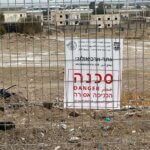Haaretz: IDF Civil Administration pushing for land takeover in West Bank
Inclusion of Jordan Valley, northern Dead Sea and area surrounding Ariel in ‘settlement blocs’ whose takeover the administration is advancing, would prevent establishment of Palestinian state with territorial contiguity.
The IDF Civil Administration is taking steps to increase state-ownership of West Bank lands, an internal military document reveals. The policy enables increased construction not only around settlement blocs like Ariel, Ma’aleh Adumim and Gush Etzion, but also in strategic areas like the Jordan Valley and Dead Sea.
Until now it was not known that the administration, which is a military agency, was charged with distinguishing between the blocs Israel is demanding to annex as part of a final-status agreement and the rest of the settlements.

Construction in the West Bank settlement of Modi’in Ilit. Photo by : AP
The document was written by Lt.Col. Zvi Cohen, head of the civil administration’s infrastructures department, in January. On the same day, Cohen signed a procedure stipulating that the custodian of government property is authorized to take possession of lands whose ownership is undefined.
The first document, setting the civil administration’s priorities in advancing Israeli take over of West Bank lands, says the construction would take place on state-owned land. Cohen writes that in view of the fact that building settlements on private Palestinian land, as in the case of most illegal outposts, constitutes a violation of international law and a government decision.
The document was passed on to the Rabbis for Human Rights under the Freedom of Information law.
The inclusion of the Jordan Valley, northern Dead Sea and area surrounding Ariel in the “settlement blocs” whose takeover the administration is advancing, would prevent the establishment of a Palestinian state with territorial contiguity. In addition, the scope of land in question thwarts the possibility of exchanging areas in a peace settlement, according to the formula presented by U.S. President Barack Obama on May 19.
This is because on the western side of the Green Line there is not enough open land to compensate the Palestinians for such an extensive annexation, according to examinations carried out during previous talks between Israel and the Palestinians.
It has recently been reported that Prime Minister Benjamin Netanyahu wants Obama to ratify the letter of his predecessor George Bush, of April 2004, saying the United States is in favor of the new borders, which take into account “the new reality on the ground,” including the existence of “major Israeli population centers.”
However, the letter says the changes on the border must have the agreement of both sides. A position paper submitted by Palestinian President Mahmoud Abbas to the American envoy George Mitchell a year ago rules out the possibility of a settlement that includes Israeli control of the Jordan Valley, northern Dead Sea and Ariel.
Cohen details the work procedures of the administration’s team, dubbed “Blue Line,” for demarcating state lands in the West Bank. He writes that the team’s major task is to examine the state’s declarations of ownership on lands mainly in the 80s and 90s. But the team, which has been working since 1999, is also examining the possibility of declaring lands with undefined ownership as state lands.
The document says the team gives priority to territories whose ownership is subject to a court debate or to dispute between settlers and Palestinians and between Palestinians and the state. The team also gives priority to advancing building public institutions, schools, parks and “other matters classified as urgent by the authorized bodies.”
The document says the team’s goal is to make sure the planning procedures and land allocations are advanced only on lands that are government property and not Palestinian-owned, in keeping with international law.
The document also says the government’s decision of 1979, saying that extending West Bank settlements and building new ones would only be carried out on state-owned land, must be adhered to.
Despite the document, dozens of settlements and outposts have been built, with the authorities’ knowledge and assistance, on private, Palestinian-owned lands. These include Ofra, Beit El and Eli and the outposts Amona, Givat Asaf and Migron, to name just a few.
The document says the Blue Line team is not required to examine and ascertain land ownership where the ownership has already been determined de facto
by illegal construction.
Dror Etkes, a left-wing activist monitoring construction in the settlements, has found that the administration’s team included at least 26 outposts in territories it defines as state lands. This means the state has started a process to legitimize these outposts.
Official information the administration gave Etkes, under the Freedom of Information Law, reveals that almost half of the Blue Line team’s work has been carried out in areas Israel defines as “settlement blocs.” Altogether the team has examined in 12 years’ work 195,000 dunams, 92,000 of them west of the approved separation fence line, and 103,000 dunams east of it.
Almost 13,000 dunams of the examined lands are located in the Dead Sea and Jordan Valley region.
In an overwhelming majority of cases the team recommended classifying the examined lands as state lands, but in some cases the team accepted Palestinians’ appeals, after appelants produced documents proving their ownership of the land.
The second document Cohen signed in January pertains to another team for examining lands whose ownership is not determined.
A letter, also passed on to the Rabbis for Human Rights, says these are “lands the custodian [of government property] is authorized to take possession of, being government property which hasn’t been declared [state lands] yet, or these procedures are still in process and are not registered in the land registry.”
Rabbis for Human Rights commented that “a politically motivated land policy must not come at the expense of the rights of a population subjected to occupation, which is excluded from the decision-making processes of those shaping its destiny. The procedures empower the ability to use the mechanism Israel set up for declaring ‘state lands’ for the purpose of dispossessing Palestinian communities and individuals of their rights and lands.”
Etkes said the document provides a rare glimpse into the delicate interface between the politicians and those carrying out their orders obediently. In 99.9 percent of the cases the procedure of declaring state lands and allocating them are aimed at benefitting the settlers, and them alone, he said.
“That’s the main way Israel enforces its discriminatory land policy, which aims to evict the Palestinians from most of the West Bank and take possession of these territories,” Etkes said.
Rabbis for Human Rights said in response that “land policies with political dimensions should not come at the expense of the rights of the population under occupation, and is banished from the decision making processes that shape their fate. The procedures enhance the ability to use the mechanism that Israel created of declaring ‘state land’ to discard Palestinian communities and individuals of their rights and their land.”






